We’re kicking off Motorcycle Safety Awareness Month with an overview of motorcycle safety laws in the U.S. Take a quick detour to learn about motorcycle history, then ride on to ensure you have the proper helmet and eye protection to stay safe and legal throughout the upcoming summer months.
Before We Get Started:
Don’t miss out! Make sure you have the databases we’ll be mentioning in this post. Follow the links below to start a trial today.
- National Survey of State Laws, 8th Edition – New Edition
- Subject Compilations of State Laws – New Edition
- Session Laws Library
- Code of Federal Regulations
Motorcycles: A Brief History
The first iteration of the motorcycle can be traced back to the second half of the 19th century. Since the 1800s, the velocipede (a collective term for unicycles, bicycles, tricycles, and other human-powered vehicles) had been a popular means of travel. As the steam engine simultaneously increased in prevalence, scientists soon realized that combining the two could provide a significant contribution to the evolution of transportation. Steam-powered bicycles soon began to appear around the world during the 1860s-1890s.
Throughout the later decades of the 19th century, manufacturers modified their bike designs for the new internal combustion engine, setting the stage for the motorcycles we know and love. In 1885, the first example of a motorcycle was produced by Gottlieb Daimler and Wilhelm Maybach. Known as the “Daimler Reitwagen,” the bike was one of the first to successfully utilize a gasoline internal combustion engine. Ten years later, German manufacturer Hildebrand & Wolfmüller developed the first mass production factory for motorcycles.
Soon after, in 1903, William S. Harley and Arthur Davidson founded the Harley-Davidson Motor Company, surviving the Great Depression to become one of the most influential motorcycle manufacturers in history. After World War II, however, motorcycles spread in popularity all around the world, particularly in Asian cities where the motorcycle became a primary means of transport. As a result, Japanese manufacturers like Suzuki, Kawasaki, and Yamaha started to dominate the industry in the 1960s. Meanwhile, in the United States, motorcycle riders began to form clubs or gangs, leading to the immortalization of the “outlaw biker” concept in the 1953 film The Wild One, starring Marlon Brando. With the emergence of biker culture in popular films and television, riding a motorcycle for sport or leisure became common.
Today, in most countries, motorcycles are legally defined as “powered two-wheel motor vehicles,” with some countries allocating less powerful bikes (like mopeds and scooters) to a different category. Other countries, including the U.S. and Canada, include three-wheeled motor vehicles in their definition.
Motorcycle Safety Laws in the United States
If you’re planning a cross-country motorcycle tour, take a moment to understand state-by-state variations in the two most common motorcycle laws: helmet use and vision protection.
To begin, users can navigate to HeinOnline’s National Survey of State Laws database. This database is updated regularly and provides an overall view of some of the most frequently sought-after and controversial legal topics in the United States. From the database home page, users will see a list of both categories and topics. To view safety laws for motorcyclists, click on Criminal Laws in the category list, and then select “Helmet and Selected Safety Laws for Motorcyclists and Bicyclists.”
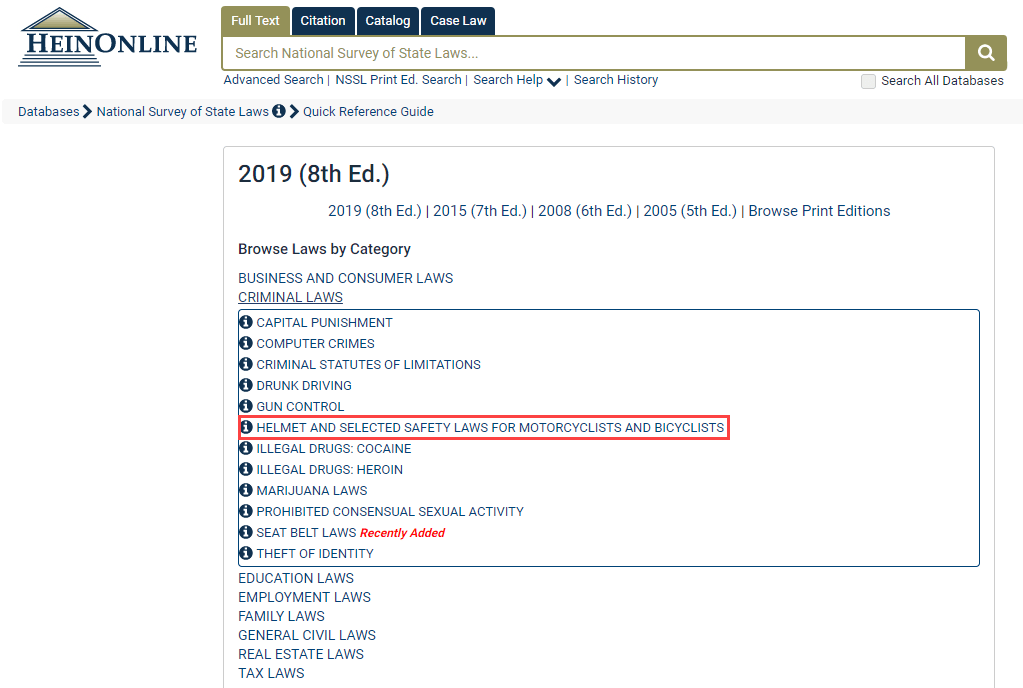
Alternatively, users can find the same link in the list of topics provided.
Selecting this link from either the list of categories or list of topics will produce a user-friendly state-by-state comparison chart of motorcycle and bicycle laws, complete with the code section and other relevant information pertaining to the law of each state.
Helmet Use Laws by State
When viewing the comparison chart, users will discover that most states require the use of a helmet when operating a motorcycle. This is a dramatic change from the 1950s and 60s when wearing a helmet was considered rather uncool. Despite this negative perception, states began mandating helmet use as early as 1967. As users can easily see, only three states (Colorado, Illinois, and Iowa) do not have any sort of requirement for helmet use.
Further criteria for motorcycle helmets may be outlined in the laws themselves. For example, many states require a “D.O.T. certified helmet,” meaning it meets the standards outlined by Federal Motor Vehicle Safety Standard 218 (FMVSS 218). The FMVSS 218 can be found in HeinOnline’s Code of Federal Regulations database.
To view a state’s motorcycle law in its entirety, users can navigate to the Session Laws Library and search using the state name as well as the code provided under Code Section in the comparison chart. To view the motorcycle helmet law for Alaska, for example, enter the Session Laws Library and search “28.35.245” AND “alaska” to bring up one result.
Vision Protection Laws by State
Referring back to the comparison chart from the National Survey of State Laws, users will find that vision protection is also required in a number of states. Depending on the state in question, vision protection can include goggles, windshields, shatter-proof safety glasses, helmet visors, and more. Users will see on the chart that sixteen states do not require any form of eye protection.
To view the vision protection law for a specific state, users can check the box next to the state name and click “Show only checked states” on the upper left portion of the page.
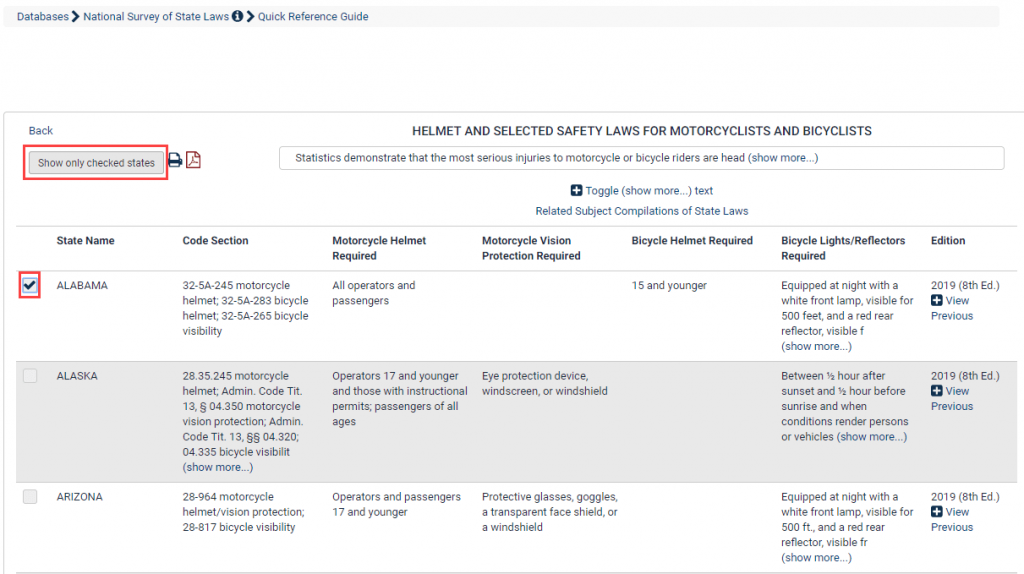
Quickly compare laws between your chosen state and others by selecting additional states from the State Filter drop-down and clicking “Reapply State Filter.”

To see how a helmet use or vision protection law has changed since the previous edition of National Survey of State Laws, click View Previous in the rightmost column of the comparison chart.
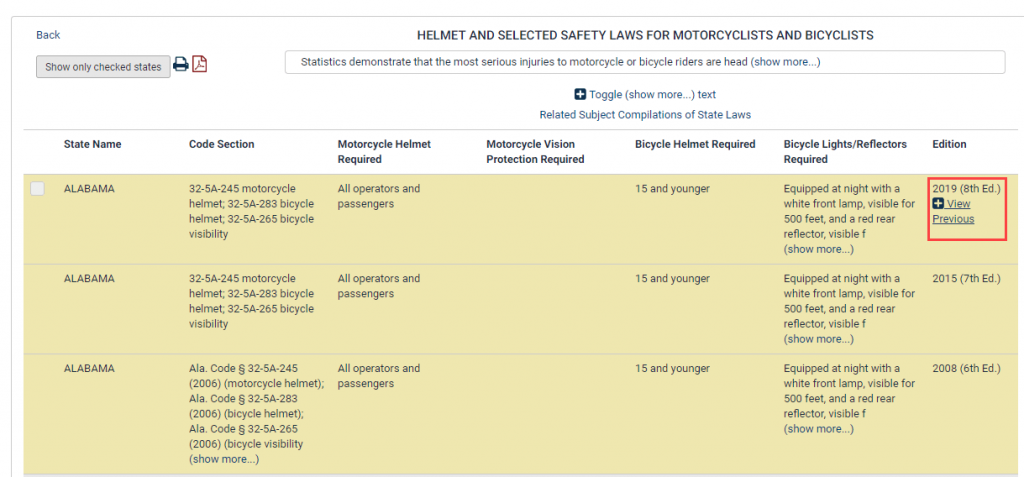
If you’re looking for a handy paper copy of the state-by-state motorcycle law comparison chart, click the PDF icon on the upper left to download a printable PDF of the page.
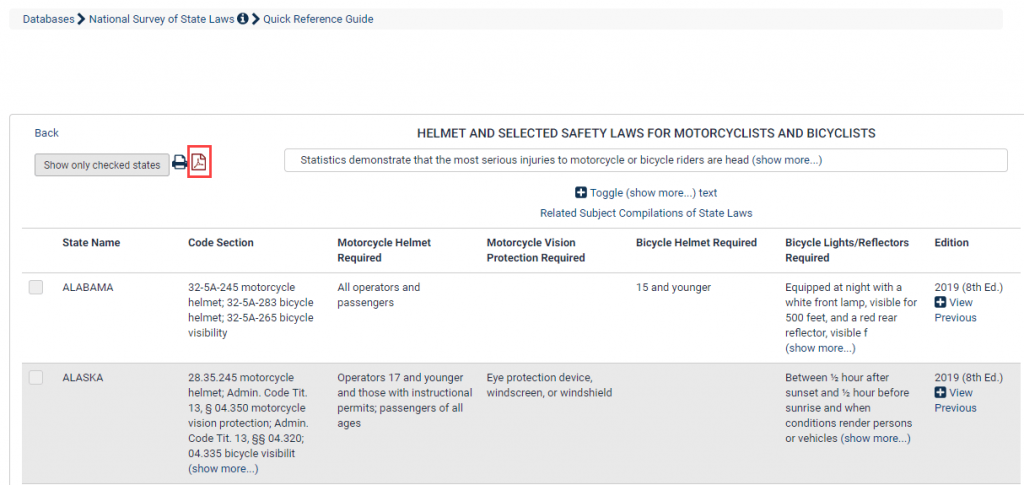
Finally, subscribers of HeinOnline’s Subject Compilations of State Laws will find that the National Survey of State Laws database links to related topics in SCSL. From the original comparison chart, simply click Related Subject Compilations of State Laws located below the topic title. A list of related subjects in the Subject Compilations of State Laws database will appear. Each subject is a link to the SCSL entries for the subject.
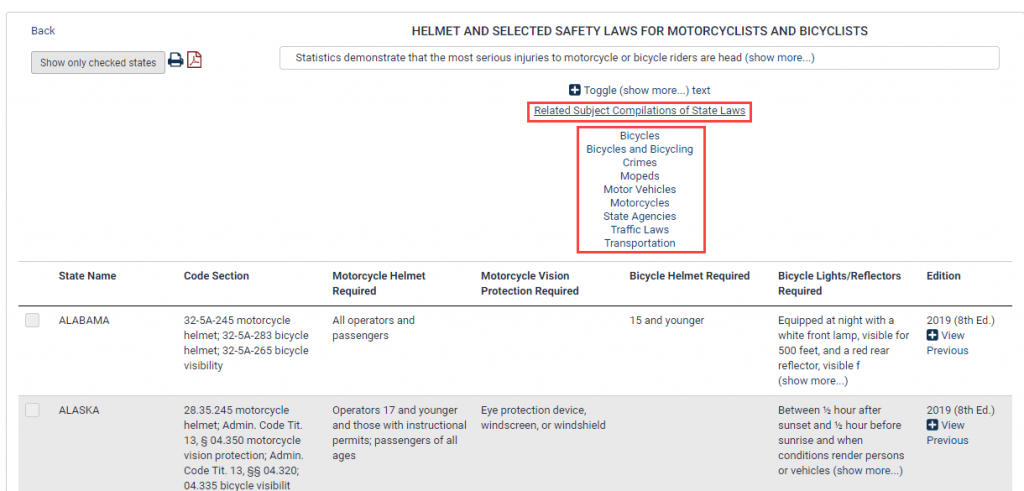
Keep it safe and legal with HeinOnline. Stay in the know and follow us on our social media platform: Facebook, Twitter, Instagram, and YouTube.



